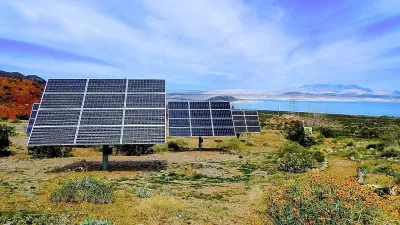The ambitious 6,000-acre project will combine an 800-megawatt solar farm with crop and livestock production.

Ohio state officials have approved a 800-megawatt solar project on 6,000 acres about 25 west of Columbus, the state’s capital. The Oak Run Solar project in Madison County will co-locate 4,400 acres of solar panels and storage with production of sheep and crops, a practice called agrivoltaics, reports the Columbus Dispatch. At a cost of $1 billion, it will be the largest project of its kind in the country, and produce enough electricity to power 170,000 homes and $8.2 million in annual tax revenue.
The Ohio Siting Board approved the project, which will be built on land partially owned by Bill Gates, though it was opposed by local officials, who said the project doubles the amount of prime farmland in the county that will be taken out of production because of solar uses. It’s a concern the practice of agrivoltaics seeks to mitigate by planting crops along the edges of solar fields and allowing livestock to graze between the panels. “In the first year of operation, Oak Run must graze at least 1,000 sheep and grow crops on 2,000 acres. Within eight years of operation, at least 70% of the farmable project area, or at least 4,000 acres, must include agrivoltaics,” reports Mark Williams for the Dispatch.
The development company, Savion, says construction could begin in 2025.
FULL STORY: Mega Madison County solar farm with Bill Gates connection wins Ohio approva

Study: Maui’s Plan to Convert Vacation Rentals to Long-Term Housing Could Cause Nearly $1 Billion Economic Loss
The plan would reduce visitor accommodation by 25,% resulting in 1,900 jobs lost.

North Texas Transit Leaders Tout Benefits of TOD for Growing Region
At a summit focused on transit-oriented development, policymakers discussed how North Texas’ expanded light rail system can serve as a tool for economic growth.

Why Should We Subsidize Public Transportation?
Many public transit agencies face financial stress due to rising costs, declining fare revenue, and declining subsidies. Transit advocates must provide a strong business case for increasing public transit funding.

How to Make US Trains Faster
Changes to boarding platforms and a switch to electric trains could improve U.S. passenger rail service without the added cost of high-speed rail.

Columbia’s Revitalized ‘Loop’ Is a Hub for Local Entrepreneurs
A focus on small businesses is helping a commercial corridor in Columbia, Missouri thrive.

Invasive Insect Threatens Minnesota’s Ash Forests
The Emerald Ash Borer is a rapidly spreading invasive pest threatening Minnesota’s ash trees, and homeowners are encouraged to plant diverse replacement species, avoid moving ash firewood, and monitor for signs of infestation.
Urban Design for Planners 1: Software Tools
This six-course series explores essential urban design concepts using open source software and equips planners with the tools they need to participate fully in the urban design process.
Planning for Universal Design
Learn the tools for implementing Universal Design in planning regulations.
Ascent Environmental
Borough of Carlisle
Institute for Housing and Urban Development Studies (IHS)
City of Grandview
Harvard GSD Executive Education
Toledo-Lucas County Plan Commissions
Salt Lake City
NYU Wagner Graduate School of Public Service





























